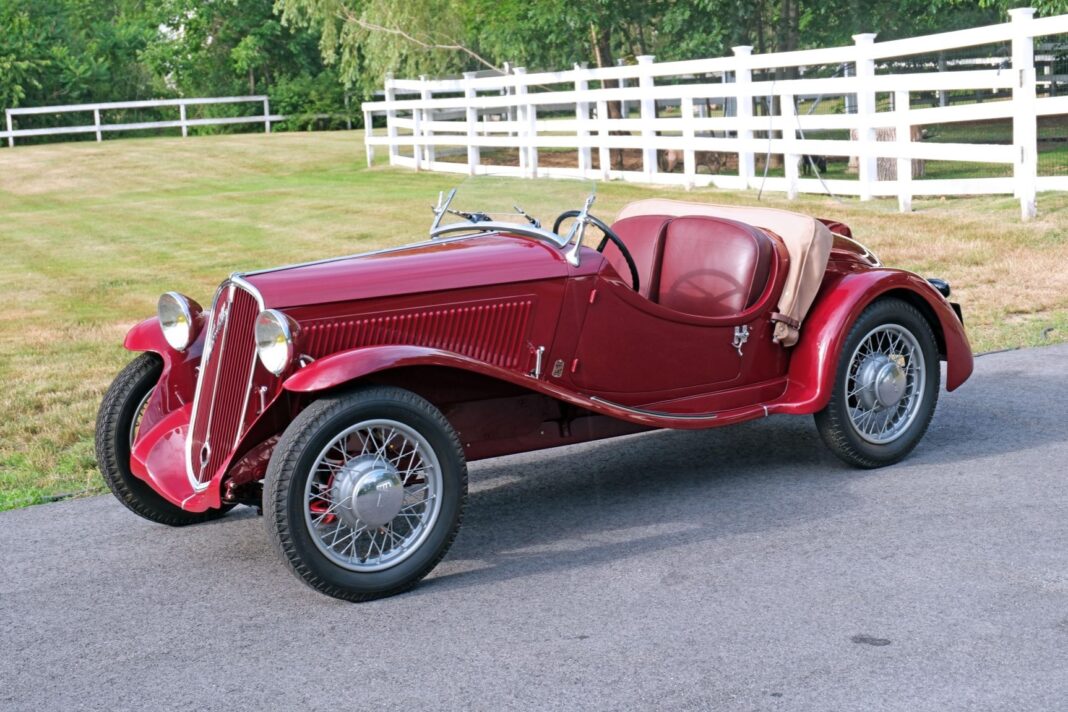This Fiat 508CS Balilla Spider Sport is noted to have been initially delivered to Fiat’s French subsidiary SAFAF as a rolling chassis in 1935 and subsequently outfitted by Carrosserie Kelsch with “Coppa d’Oro” bodywork featuring full-flowing fenders. Chassis 13442 underwent a refurbishment at some point prior to 2008, when it was acquired by the previous owner. Further work was later carried out in the early 2020s by D.L. George Historic Motorcars of Cochranville, Pennsylvania, after which the car was purchased by the seller in 2021. The red-over-red spider is powered by an 1,100cc overhead-valve inline-four that breathes through a single Solex carburetor, while shifting is via a four-speed manual transmission. It rides on 17″ wire wheels and is further equipped with hydraulic drum brakes and Houdaille lever-arm shock absorbers at all four corners. Further details include staggered seating for two, Jaeger instrumentation, a tan soft top, and Marchal headlamps with amber bulbs. This 508CS Spider Sport is now offered with a New Hampshire title in the seller’s name that lists the vehicle as a 1933 model.
The 508 Balilla platform was introduced in 1932 featuring power from a side-valve inline-four with a choice of open or closed body styles. Joining the lineup in 1933 was a Spider Sport variant featuring two-door, two-seat bodywork styled by Ghia, which the model retained when it was updated with a Siata-tuned, overhead-valve engine in 1934. This collaboration between Fiat, Ghia, and Siata was offered either with full-flowing fenders or as a lighter-weight Corsa version with cycle fenders and absent of running boards. The 508S competition model’s résumé included class wins in the Mille Miglia, Le Mans, Targa Florio, and Rallye Monte Carlo.
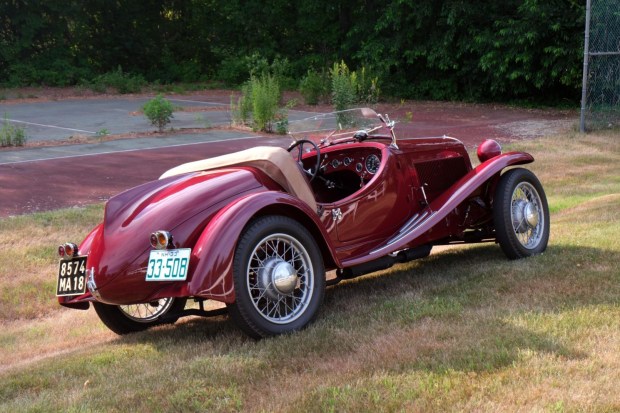
This second-series example was reportedly delivered new as a rolling chassis to Société Anonyme Française pour la Fabrication en France des Automobiles FIAT, known as SAFAF, in 1934 before being fitted with “Coppa d’Oro” bodywork by Carrosserie Kelsch. The seller states that this car’s ownership is not known prior to 2008, and as such its early provenance is not verified. It was refinished in red as part of a refurbishment completed under previous ownership, and styling features include full-flowing fenders, low-cut doors, a rearward-sloping grille, louvers along the centrally hinged hood, and a rear fin integrated into the tail panel. A bulge at the front right of the hood and adjacent body panel is distinct to the Sport model and accommodates the positioning of a dynamo in the engine bay behind it. A Kelsch badge appears ahead of the left door, and the car is further appointed with Marchal headlamps, taillights, and windshield wiper arms.
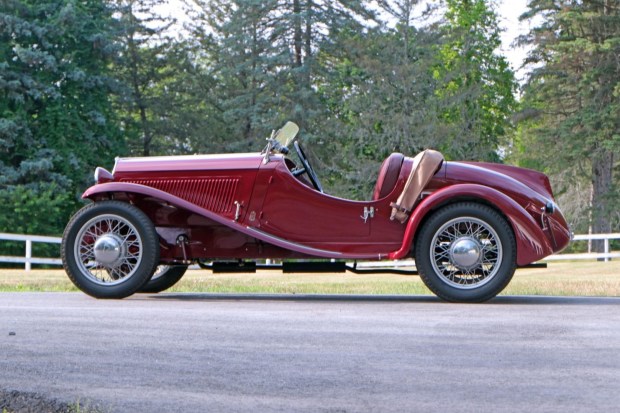
Four-bolt wire wheels feature silver painted rims accented by F-logo hubcaps and are mounted with 4.25-width Pirelli tires. A matching spare wheel is secured below the tail panel. Stopping is handled by hydraulic drum brakes with internally acting shoes at each wheel, while a handbrake applies force to a drum between the gearbox and driveshaft.
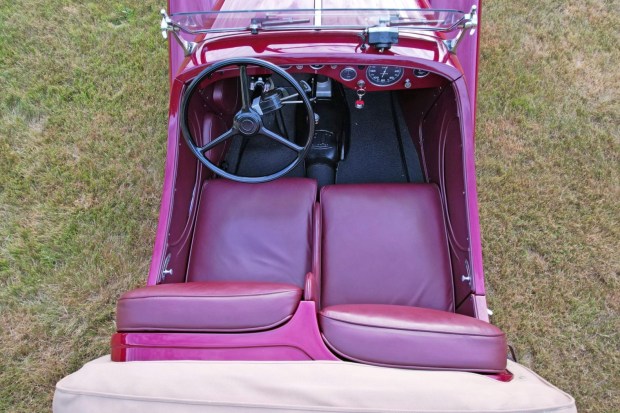
The cockpit houses seating for two with the driver’s seat staggered just forward of the passenger’s. Red leather covers the seats, center bolster, and lower dash as well as the door and kick panels. A tilting Sécurit windshield with Marchal electric wipers powered by a Bosch motor sits ahead of the cabin. The tan soft top can be stowed overtop the rear of the body, and textured black mats line the floors.
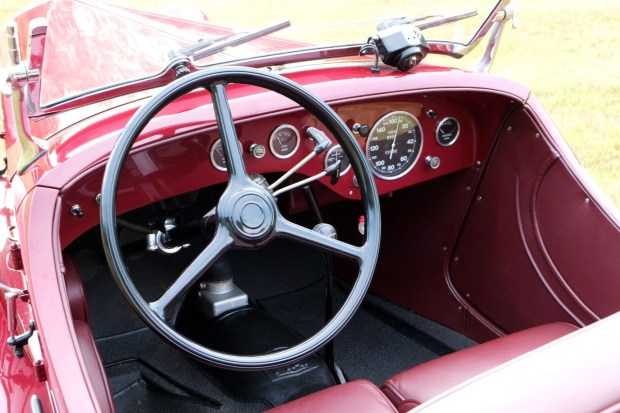
A three-spoke steering wheel sits ahead of a body-color dash panel housing French-language Jaeger instrumentation including a reverse-sweep 160-km/h speedometer and gauges monitoring oil pressure, water temperature, amperage, and fuel level. The five-digit odometer shows 555 kilometers (~345 miles), and total mileage is unknown.
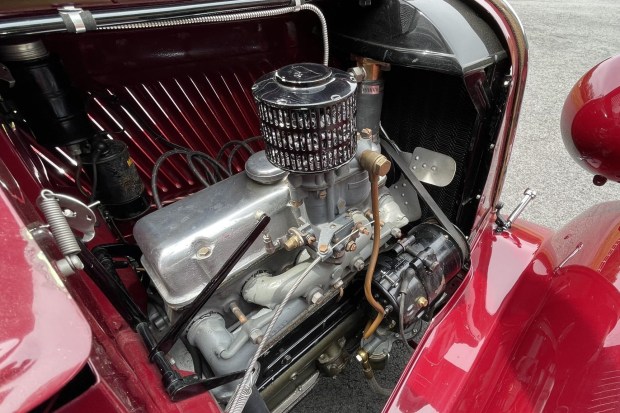
The 1,100cc Tipo 108CS inline-four features three main bearings and is topped with a Siata-produced cylinder head with pushrod-operated overhead valves, which helped bring the factory-rated output to 46 horsepower at 4,400 rpm. Induction is via a single Solex down-draft carburetor topped by a Fergat air cleaner, and further appointments include a Marchal coil, generator, and starter as well as a belt-driven dynamo.
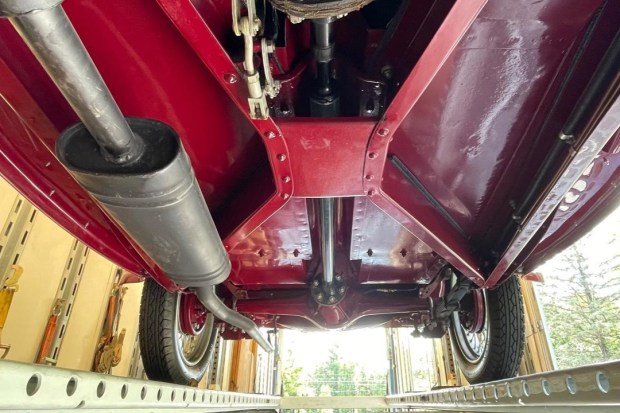
Power is transferred to the rear wheels via a four-speed manual transmission with a dry-plate clutch and a 4.33:1 rear end. The suspension incorporates solid axles with semi-elliptical leaf springs and Houdaille lever-arm shock absorbers at each corner, while steering is through a worm and roller setup. The cruciform-braced chassis features a wheelbase of 7’6″ and a 3’10″ track.
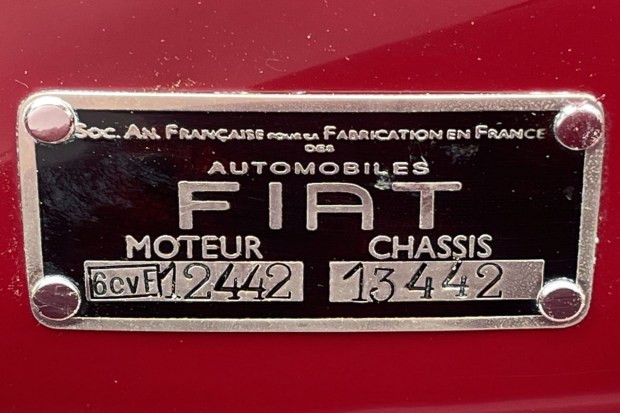
Chassis number 13442 is shown above. The car is titled using the sequence FIA1344233, which the seller tells us is a New Jersey–assigned VIN featuring an “FIA” prefix for Fiat and the previously believed year of construction “33” at the end. The current New Hampshire title carries an “Antique Vehicle” brand.
You are not connected to real-time updates. Attempting to connect.
Your real-time updates could not be connected. Missed updates will be sent once your connection has been reestablished.
Your real-time updates could not be connected. Missed updates will be sent once your connection has been reestablished.
Your real-time updates could not be connected. Missed updates will be sent once your connection has been reestablished.
